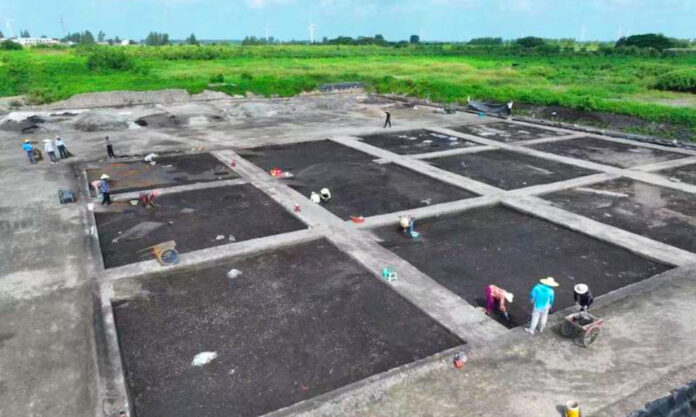Under the gaze of today’s super-tall wind turbines transitioning us from fossil fuels, in Jiangsu there has been discovered evidence of our first polluting efforts 7,000 years ago; a friction-based, fire-making device from the now earliest known Neolithic site in eastern China.
The discovery site is being called Caoyan Port, located on the north side of Dongyan Jiawei of Caowang Village in Jiangsu’s Xinghua City that falls under the administration of Taizhou.
With an elevation of less than 2 metres, the sodden area was originally populated by reeds and water plants. In the 1980s and 1990s, the lake was reclaimed to be farmland, forming a large area of fish ponds.
One of those ponds were excavated in 2021, leading to the discovery of the site. After an investigation by the Nanjing Museum Archaeology Institute, it was confirmed to date back 7,200 years and be over 80,000 square metres in area.
With the approval of the National Cutural Heritage Administration, the Nanjing Museum and the Jiangsu Provincial Institute of Cultural Relics and Archaeology, a thorough archaeological excavation of the site began in December of last year, and now the results of those efforts are beginning to be presented to the public.
As per a report by The Paper on 23 August, an enormous variety of relics have been unearthed to date. According to Gan Huiyuan, Deputy Research Librarian of the Nanjing Museum and Archaeological Excavation Team Leader of the Caoyan Port Site, the large number of bone and wooden artefacts unearthed are not commonly seen in Neolithic sites of the same period.
Among them, there are various types of tools made of bone, including arrowheads, darts, daggers, plates, hairpins and needles, most of which exquisitely crafted. There is even a Bansuri (six-holed) bone flute in a semi-finished condition. Experts say that these unearthed relics not only showcase the lifestyles of our ancestors, but also their aesthetic tastes.
Then there is all the wooden ware; spinning wheels, floats and that most remarkable of finds; the friction-based, fire-making hand drill on which are evident drill holes and burn marks.
That those can still be seen clearly some 7 millennia later indicates our ancestors must have really put their back into it. As the now somewhat politically incorrect website, artofmanliness.com, put it in 2008, “The hand drill method is the most primeval, and the most difficult to do. All you need is wood, tireless hands and some gritty determination”.
With fire now to hand, something to cook with would be next for Jiangsu’s neolithic inhabitants. Unearthed at the Caoyan Port Site were also a number of cauldrons, together with the remains of that likely cooked in them; deer, pigs, cows, dogs and various types of birds.
Also somewhat tellingly is the abundance of water-based life forms; gorgonian fruits, water chestnuts and rice, reflecting a rich-dietary structure and a relatively-advanced hunter/gather-oriented economic model.
Lastly, long-lost remains of clams, snails and oysters were discovered. As the crow flies today, it is well over 100 kilometres to the sea. The finds at the Caoyan Port Site are therefore also highly suggestive that 7,000 years ago, this was not the case.









